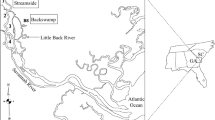Abstract
In response to concerns about amphibian declines, a study evaluating and validating amphibian monitoring techniques was initiated in Shenandoah and Big Bend National Parks in the spring of 1998. We evaluate precision, bias, and efficiency of several sampling methods for terrestrial and streamside salamanders in Shenandoah National Park and assess salamander abundance in relation to environmental variables, notably soil and water pH. Terrestrial salamanders, primarily redback salamanders (Plethodon cinereus), were sampled by searching under cover objects during the day in square plots (10 to 35 m2). We compared population indices (mean daily and total counts) with adjusted population estimates from capture-recapture. Analyses suggested that the proportion of salamanders detected (p) during sampling varied among plots, necessitating the use of adjusted population estimates. However, adjusted population estimates were less precise than population indices, and may not be efficient in relating salamander populations to environmental variables. In future sampling, strategic use of capture-recapture to verify consistency of p's among sites may be a reasonable compromise between the possibility of bias in estimation of population size and deficiencies due to inefficiency associated with the estimation of p. The streamside two-lined salamander (Eurycea bislineata) was surveyed using four methods: leaf litter refugia bags, 1 m2 quadrats, 50 × 1 m visual encounter transects, and electric shocking. Comparison of survey methods at nine streams revealed congruent patterns of abundance among sites, suggesting that relative bias among the methods is similar, and that choice of survey method should be based on precision and logistical efficiency. Redback and two-lined salamander abundance were not significantly related to soil or water pH, respectively.
Similar content being viewed by others
References
Ash, A.N.: 1997, ‘Disappearance and Return of Plethodontid Salamanders to Clearcut Plots in the Southern Blue Ridge Mountains’, Conservation Biology 11, 983-989.
Atkinson, J.: 1994, ‘Fisheries Management and Data Report. Shenandoah National Park’, unpublished report.
Banasiak, C.F.: 1974, Population Structure and Reproductive Ecology of the Red-backed Salamander in DDT-treated forests of Northern Maine, Ph.D. thesis, University of Maine, Orono, Maine.
Bonneau, J.L., Thurow, R.F. and Scarncechia, S.L.: 1995, ‘Capture, Marking, and Enumeration of Juvenile Bull Trout and Cutthroat Trout in Small, Low-conductivity Streams’, N. Am. J. Fish. Manage. 15, 563-568.
Burton, T.M. and Likens, G.E.: 1975, ‘Salamander Populations and Biomass in the Hubbard Brook Experimental Forest, New Hamsphire’, Copeia 1975, 541-546.
deMaynadier, P.G. and Hunter Jr., M.L.: 1995, ‘The Relationship Between Forest Management and Amphibian Ecology: a Review of the North American Literature’, Environmental Review 3, 230-261.
Gergits, W.F. and Jaeger, R.G.: 1990, ‘Site Attachment by the Red-backed Salamander, Plethodon cinereus’, J. Herpetol. 24, 91-93.
Heyer, W.R., Donnelly, M.A., McDiarmid, R.W., Hayek, L.C., and Foster, M.S.: 1994, ‘Measuring and Monitoring Biological Diversity: Standard Methods for Amphibians’, Smithsonian Institution Press, Washington, DC, 364 pp.
Lancia, R.A., Nichols, J.D. and Pollock, K.H.: 1994, ‘Estimating the Number of Animals in Wildlife Populations’, In: Bookhout, T.A. (ed.), Research and Management Techniques for Wildlife and Habitats. 5th edition. The Wildlife Society, Bethesda, Maryland.
Maryland Department of Natural Resources: 1995, Maryland Biological Stream Survey: Ecological Status of Non-Tidal Streams in Six Basins Sampled in 1995.
Menkens, G.E. and Anderson, S.H.: 1992, ‘Estimation of Small-Mammal Population Size’, Ecology 69, 1952-1959.
Mitchell, J.C.: 1998, ‘Amphibian Decline in the Mid-Atlantic Region: Monitoring and Management of a Sensitive Resource’, Final Report, Legacy Resource Management Program, U.S. Department of Defense.
Otis, D.L., Burnham, K.P., White, G.C. and Anderson, D.R.: 1978, ‘Statistical Inference from Capture Data on Closed Animal Populations’, Wildl. Monogr. 62, 1-135.
Pauley, T.K.: 1995, ‘Aquatic Salamanders’, in: Effects of Diflubenzuron on Non-target Oganisms in Broadleaf Forested Watersheds in the Northeast, Reardon, R.C. (ed.), USDA Forest Service, National Center of Forest Health Management, FHM-NC-05-95.
Petranka, J.W.: 1998, ‘Salamanders of the United States and Canada’, Smithsonian Institution Press, Washington, DC.
Rexstad, E. and Burnham, K.: 1991, ‘User's Guide for Interactive Program CAPTURE: Abundance Estimation of Closed Animal Populations’, Colorado Cooperative Fish & Wildlife Research Unit, Colorado State University, Fort Collins, Colorado.
Roach, S.M.: 1996, ‘Influence of Electrofishing on the Survival of Arctic Grayling, Chinook Salmon, Least Cisco, and Humpback Whitefish Eggs’, Alaska Dept. Fish and Game, Fishery Management No. 96-1 Project Number AK F-010-10/Job R-3-2(b), AK F-010-11/Job R-3-2-9(b), 26 pp.
Sauer, J.R. and Williams, B.K.: 1989, ‘Generalized Procedures for Testing Hypotheses about Survival or Recovery Rates’, J. Wildl. Manage. 53, 137-142.
Skalski, J.R. and Robson, D.S.: 1992, ‘Techniques for Wildlife Investigations: Design and Analysis of Capture Data’, Academic Press, New York, 237 pp.
Storm, G.L., Fosmire, G.J. and Bellis, E.D.: 1994, ‘Persistence of Metals in Soil and Selected Vertebrates in the Vicinity of the Palmerton Zinc Smelters’, J. Environ. Qual. 23, 508-514.
Taub, F.B.: 1961, ‘The Distribution of the Red-backed Salamander, Plethodon c. cinereus, within the Soil’, Ecology 42, 681-698.
USEPA: 1990, Biological Criteria: National Program Guidance for Surface Waters, Office of Regulations and Standards, Washington, DC, EPA-440/5-90-004.
University of Delaware: 1991, Recommended Soil Testing Procedures for the Northeastern United States: Northeastern Regional Publication No. 493, Agricultural Experiment Station, University of Delaware, Newark, Delaware.
Witt, W.L.: 1993, ‘Annotated Checklist of the Amphibians and Reptiles of Shenandoah National Park, Virginia’, Catesbeiana 13, 26-35.
Wyman, R.L. and Hawksley-Lescault, D.S.: 1987, ‘Soil Acidity Affects Distribution, Behavior, and Physiology of the Salamander Plethodon cinereus’, Ecology 68, 1819-1827.
Wyman, R.L.: 1998, ‘Experimental Assessment of Salamanders as Predators of Detrital Food Webs: Effects of Invertebrates, Decomposition and the Carbon Cycle’, Biodiversity and Conservation 7, 641-650.
Author information
Authors and Affiliations
Rights and permissions
About this article
Cite this article
Jung, R.E., Droege, S., Sauer, J.R. et al. Evaluation of Terrestrial and Streamside Salamander Monitoring Techniques at Shenandoah National Park. Environ Monit Assess 63, 65–79 (2000). https://doi.org/10.1023/A:1006413603057
Issue Date:
DOI: https://doi.org/10.1023/A:1006413603057




